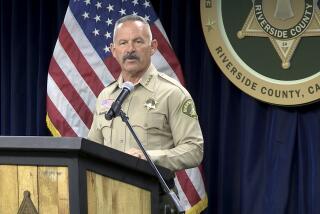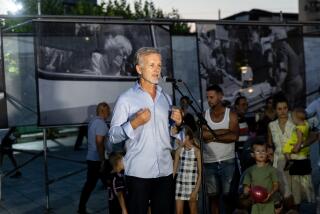The Genuine Article : Cowboy, Rodeo Legend Harley May Still Be Ridin’ On
Trail boss Harley May first sensed trouble when one of his volunteer cowboys showed up for the cattle drive wearing a baseball cap.
Sure enough, shortly after 60 head of cattle began the trek from San Juan Capistrano to a rodeo site in Rancho Santa Margarita on a sunny day last month, one of the weekend cowpunchers--a local Rotarian in real life--tumbled his mount into a gully.
“We had to use ropes to get the horse out, and, fortunately, nobody was hurt,” May said wryly, shaking his head slightly. “Now, some of those guys were real city slickers. Real cowboys don’t wear baseball caps.”
Tall and lean as a fence post, face darkened and weathered by more than 50 years of working outdoors on ranches and competing at rodeos across the country, Harley May knows a real cowboy when he sees one.
Experts say there are two kinds of cowboys today--working cowboys who spend their time on the ranch, and professional cowboys who enter rodeos for cash prizes. The 68-year-old May, a three-time national rodeo champion and a cowboy legend, is both.
“That’s what makes him so unique,” said Gilbert Aguirre, manager of 40,000-acre Rancho Mission Viejo in South County, where May works as a “cowboy consultant.”
“He pioneered the modern rodeo and in his era was probably the best competition cowboy going down the road,” Aguirre said. “But he’s really a ranch cowboy who happened to be a rodeo cowboy.”
Sitting on the porch of the modest one-story home he shares with his wife, Lynn, May reflected that “working cowboys are part of a lifestyle that’s vanishing along with the big private cattle ranches.”
“When I started rodeo in 1953, most of the cowboys were real working cowboys. Now there aren’t very many working cowboys at all in the rodeo.”
Pointing to a small cluster of cattle grazing in a nearby meadow, May said, “Today’s rodeo cowboy would have no idea how to gather a herd and move ‘em.
“It’s nothing you can get out of a book. You just have to get out and do it.”
A past president of the National Rodeo Cowboys Assn., May stays in touch with rodeo by serving as the chairman of the association’s rules committee and judging local competition. He plans to work at least one rodeo later this summer in Costa Mesa or San Juan Capistrano.
But in his day, May was one of the best rodeo cowboys to ever strap on a pair of chaps, say rodeo aficionados.
He started tossing 1,600-pound steers to the ground in 1953, when people still put rodeo in the same class as Wild West circus shows.
May was one of the first rodeo cowboys to graduate from college--today, cowboys pour out of several colleges and trade schools in the Southwest that offer competitive rodeo classes.
Pilot’s license in hand, May was also one of the first “flyboys,” hopping by plane to as many as seven rodeo competitions in a single weekend.
“He was a superstar in his time,” Aguirre said. “He’s really a living legend, and there’s not many of his kind left.”
*
May’s modest ranch home is like a museum, filled with photos, awards and other memorabilia from his rodeo career.
Most striking are the bronze statues, frozen moments of frenzied action showing a cowboy hanging on to a bucking bronco or grabbing a huge bull in a headlock--all tributes to May taken from action snapshots.
“I’ve seen the whole spectrum (in rodeo), starting from the ‘50s and ‘60s,” May said. “Rodeo today is more popular than ever. The top rider won about $250,000 last year,” contrasted with May’s largest annual prize winnings of $34,000 in 1956.
Asked to compare the two eras, May ruminates for a moment before deciding, “I like the old days the best. There weren’t as many people in rodeo, and we knew each other pretty good.
“You got to know people a lot more personally. Even though we competed against each other, we’d exchange tips and information about the horses and steers.”
When he was in his early 20s, Jim Charles traveled the rodeo circuit with May. They competed in front of sparse audiences perched on rickety bleachers at dusty little towns throughout the West and before a packed arena in New York City’s Madison Square Garden.
“Harley was like a big brother or a father to me,” said the 58-year-old Charles, an Oakdale resident who guides hunters and anglers in the wilderness outside the Sacramento area. “Everybody respected Harley because he went to college and was always reliable.
“As a steer wrestler, he just had a way to get the bulls down quicker than anybody. There was plenty (of rodeo cowboys who were) stronger, but nobody was ever able to copy him, though many tried.”
Although May, a native of New Mexico, is outwardly soft-spoken and gentle, Charles recalled one time when his ex-running buddy showed his temper when crossed.
After a night of celebration following a rodeo, the men’s boarding house was visited in the early morning by a thief, who stole May’s bankroll and car keys. But the man was found a block away trying to escape and dragged back to the cowboys’ boarding room.
“Harley just banged him one on the head and the guy said, ‘Please don’t hit me no more, I got a plate on my head,’ ” Charles said. “Harley asked him, ‘Where?’ and the guy pointed to a spot on his noggin. Harley banged him on the head again in another place.”
Of all the trophies in his house, one in particular shows the steel of May’s personality. Retiring from active participation in the rodeo circuit while in his mid-30s, May kept chasing after the one major title that eluded his grasp: the Calgary Stampede Rodeo steer wrestling championship.
May finally won the title. At age 47.
“Harley’s from the old school,” Aguirre said. “He will absolutely do what he says he’s going to do. If he says he’ll meet you at the North Pole on New Year’s Eve in 1999, he’ll be there.”
More to Read
Sign up for Essential California
The most important California stories and recommendations in your inbox every morning.
You may occasionally receive promotional content from the Los Angeles Times.










